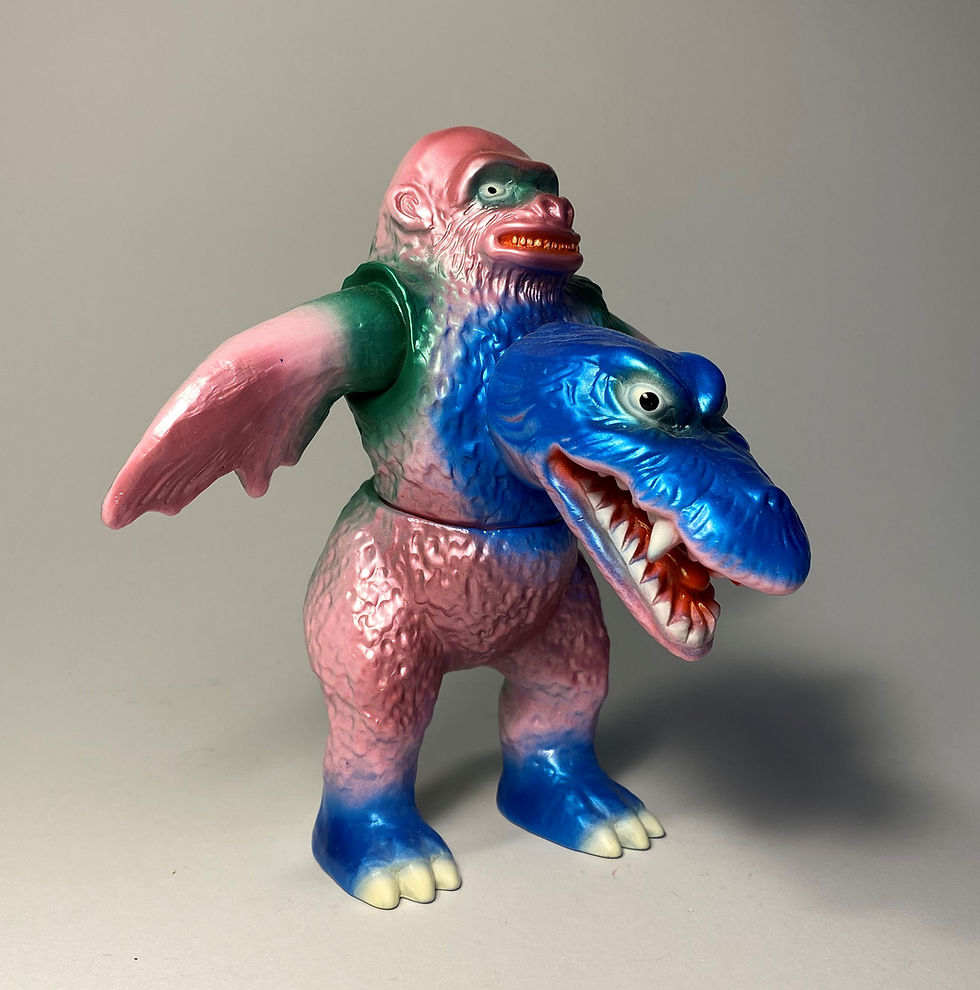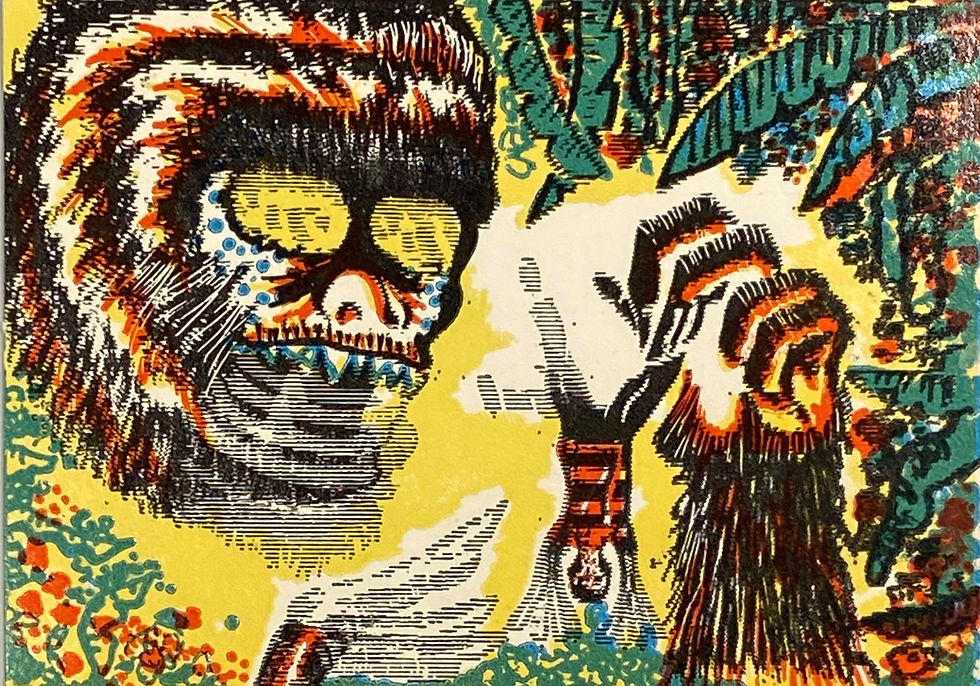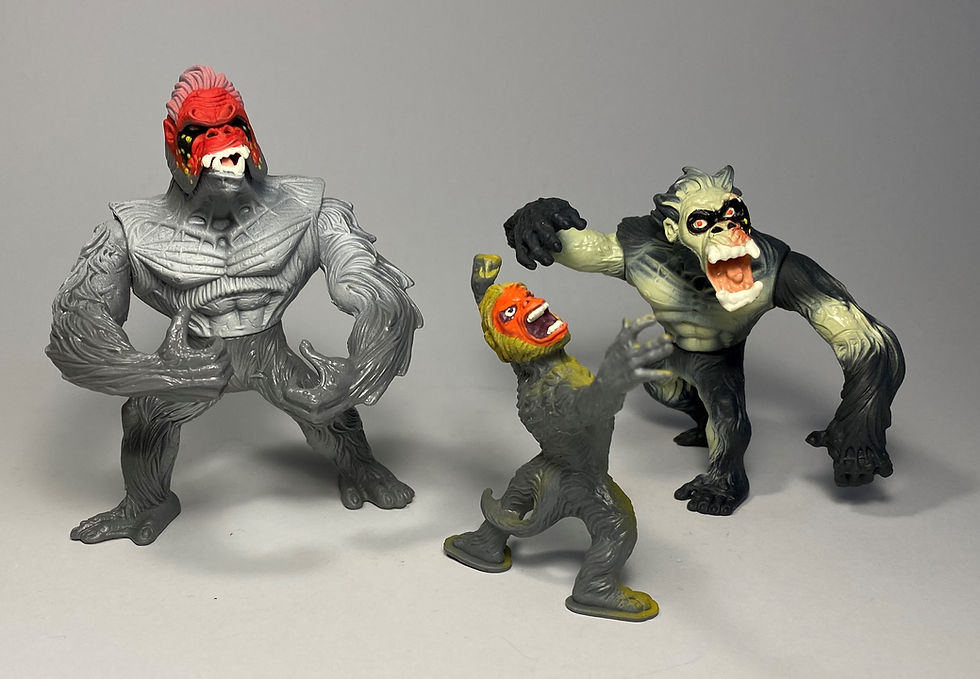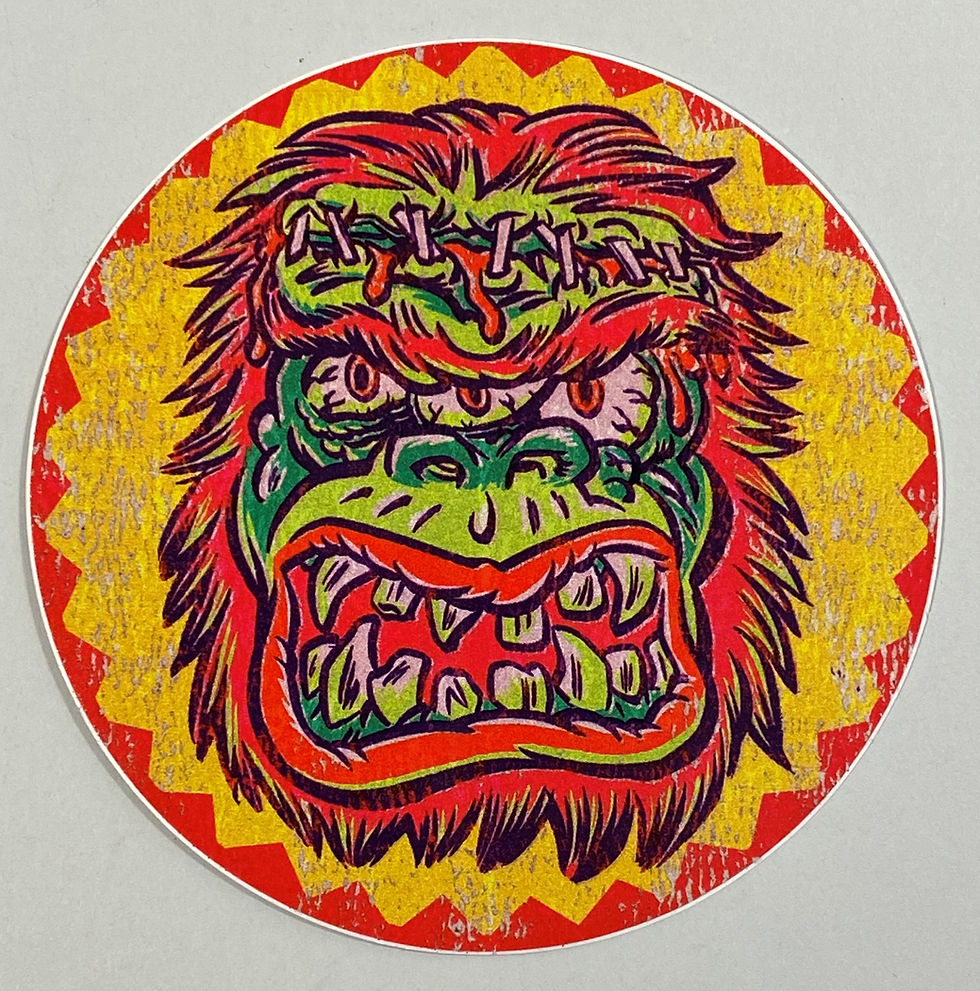III: Going Ape!
- de Gustibus

- Mar 25, 2020
- 6 min read
Updated: Apr 23, 2020
And now for something completely different (sort of). From the typographical (Post I) and the macabre (Post II) to the irreverent. Here’s another entry for A Year in the Library in which a theme is presented for you based on books and objets divers from my collections. At the very least, I hope these diversions provide you a modicum of amusement.
So, apes. Perhaps it was my exposure to early Warner Brothers cartoons as a child, wherein mad apes were bested by a certain rascally rabbit. Maybe it was Bumble, the abominable snowman (snow-ape, really), friend to Rudolph. Or it could just be that apes are monstrous and monsters appeal to me for some reason (keep watching for upcoming posts if you don’t believe me). Then there’s also the more universal fascination with apes. Apes as our (not so) distant cousins, as mirrors of our own behavior, so easily anthropomorphized. And more to the point, aren’t we all going a little ape these days?
Not my circus, not my monkeys goes the old Polish proverb? Well these ARE my monkeys (or rather my apes)...
Some Japanese sofubi apes...
Sofubi is a term used to describe soft vinyl toy dolls (often monsters) from Japan. I believe it is derived from the pronunciation of “soft vinyl” in Japanese; “sofuto-bineeru”. Sofubi monsters (kaiju) began appearing in the in 1960s, often depicting licensed characters from science fiction TV shows like Ultraman and giant monster movies such as Godzilla. In fact, Godzilla’s name is derived from a combination of the Japanese for Gorilla (gorira) and Whale (kujira) as the creature was originally conceived as a composite of the two. In addition to sea creatures (oh look, an idea for another post!), apes frequently served as the inspiration for monsters and villains in Japanese movies and on TV.
Yeti Apes: Gigass Kaiju (1978).
Sofubi by Popy, about 17 cm.
Gigass was a Yeti-like creature from the “Frozen Monster” episode of the Japanese TV show Ultraman. It’s difficult to imagine being terrorized by a creature with such a nonplussed expression, but he was summarily dispatched by the Science Patrol nonetheless.

Robot Apes: Mechani-Kong (1991).
Sofubi by Bandai, about 18 cm.
As if King Kong weren’t enough, the producers of King Kong Escapes (1967) saw fit to include a robotic Mechani-Kong as the film’s antagonist. I never understood why he was designated Mechani-Kong instead of Mechakong (like Mechagodzilla), but perhaps that’s just me.

Cyborg Apes: Fire Kong (2017).
Sofubi by Medicom, about 26 cm.
Not to be confused with robot apes, this cyborg ape first appeared as a character in the 1980 TV show Kamen Rider Super-1. This is one of those instances where I knew nothing about either the character or the show but acquired the piece based purely on the sheer visual lunacy of it all. I believe the belt signifies membership in some evil society or other. A bit over the top if you ask me as all the evil societies to which I belong use tasteful signet rings for self-identification.

Alien Apes: Black Hole Planet 3 Alien (2013).
Sofubi by Marmit, about 22 cm.
Beware of apes brandishing ray guns. While this aphorism may appear self-evident to some, you’d be surprised just how many people miss the first signs of extraterrestrial world domination. The Black Hole Third Planet People (does that make us the Yellow Sun Third Planet People? So much more lyric than homo sapiens.) appeared in two Godzilla movies, Godzilla vs. Mechagodzilla (1974) and Terror of Mechagodzilla (1975). Initially appearing as humans, they were later revealed to be bluish-green faced apes. With ray guns.

Pachi Apes: King Kong(s) (c. 2010).
Sofubi by Skull Head Butt, about 25 cm.
Pachi is a Japanese term used to describe unlicensed or bootleg items. Producing knockoffs saved the manufacturers licensing fees, and in the case of sofubi, led to some wonderfully bizarre and crude toys. In homage to this tradition, modern sofubi designers amped up the weird with great kitschy results.
As part of their B-movie line, the Japanese sofubi producer Skull Head Butt issued a King Kong doll. Not one to rest on their vinyl laurels, they then issued several two-headed versions of which this is one.

Pachi Apes: Um, you tell me (c. 2010).
Sofubi by Amipro, about 18 cm.
And then there’s this. Take one gorilla, add one monstrous lizard head, sprinkle in two bird wings, mix thoroughly and voilà: a kaiju chimera. The contrasting expressions on the two faces is worth it alone.

Kawaii Apes: Goro (1998)
Sofubi by Marmit, about 13 cm.
The term kawaii means cute in Japanese. Big baby eyes and saccharin-sweet expressions characterize these sorts of figures. This one is of a character from the TV show Ultra Q (a precursor to Ultraman). Originally a monkey, Goro was transformed by a drug into an enormous gorilla. One of the few creatures not killed by the hero or his team, Goro now resides in tranquility on an ape island somewhere.

Some comic book apes...
Ditko's Monsters: Konga! (2013)
Hardcover book, IDW. About 22 x 29 cm. 328 pp.
A tome of pure simian joy reprinting comics from the 1960s that were inspired by the 1961 movie. A King Kong-esque gorilla battles aliens, dinosaurs, and fascists as related by one of the great comic book artists, Steve Ditko. This is one of many volumes researched and compiled by Craig Yoe, a comic book historian and archivist who admirably reintroduces us to some of the more obscure (and entertaining) examples of the art form.

Apes and aliens again. They’re practically synonymous. And what a metaphor: muscles crawling with mighty power!

Uh-oh...

Gorilla Grodd (2008)
Action figure by DC Direct, about 17 cm.
Gorilla Grodd is to the Flash as Lex Luthor is to Superman. If, that is, Lex were a super-intelligent ape who developed telepathic powers though exposure to a glowing meteor. Other than that- no difference. I’ve never seen such a conspicuously neutered action figure as this one. Perhaps it explains why Grodd chose the path of evil (in contrast to the other, more benign citizens of Gorilla City). Beware of meteors, glowing or otherwise. Dominus dedit Dominus abstulit.

Some ape ephemera...
Monster Magic Action (1960s)
Trading card, about 6 ½ x 9 cm.
This is part of a set of trading cards sold in blister packs during the 1960s. Each pack came with a lenticular “lens” (i.e., finely scored sheet of plastic) that when moved across the trading card gave the illusion of movement, albeit in a rather staccato fashion. Even without the fourth dimension, the wonderfully garish colors and brutish printing create an aesthetic all its own.

Monsters [Masks] (1960s).
Cardboard punchout mask, about 20 x 27 cm.
What midcentury kid wouldn’t want to run around the house wearing one of these? Part of a set of six masks which included Frankenstein and other traditional “monsters”, the expressive face epitomizes manic rage (and the freedom that it confers upon the wearer). It creates an ape-persona, unencumbered by of all those societal rules and constraints.

Gorilla (1980s).
Plastic vacuform mask, about 25 x 19 cm.
More veristic and less stylistically interesting than the paper mask above, this one reminded me a bit of the flying heads from the movie Zardoz. As the rules of A Year in the Library prohibit me from illustrating anything that is not part of The Collection, I’m afraid you’ll have to Google this one to see if you agree.

Congo: Lost City of Zinj Apes (1995).
Action figures by Mattel, about 9 to 13 cm.
Who would make toys of murderous inbred mutant movie apes that were consumed in a torrent of scalding lava? Mattel, apparently.

King Kong (1970s?).
Rubber toy “jiggler”, about 21 cm.
A decidedly non-veristic representation of the most famous ape of modern times, King Kong. Dictates of curatorial ethics expressly prohibit exhibiting any form of favoritism for a particular object in a given collection, but...

Gorilla (1970s).
Italian cromo (sticker), about 5 x 7 cm.
There’ll be plenty of more space allotted to these wonderfully pulpy Italian cormos in a forthcoming post, but for now, this one will have to suffice. It just screams ape, doesn’t it?

Go Go Gorilla (2011/2015).
Vinyl sticker by Ben Von Strawn. About 15 cm.
This one falls under the category of mad (in the traditional sense) apes that your otherwise reserved archivist finds (visually) irresistible.

Acid Ape (c. 2018)
Vinyl sticker. Glorp Gum. About 10 cm.
A pop art three-eyed Frankenstein-ape sticker with faux aging reminiscent of underground comics and 1960s decals.

Tarzan Digest #1 (1972)
DC Comics, about 12 x 18 cm.
And now, the Pièce de résistance. Relegated to the back of a digest of comic book reprints is the one reference text without which no serious library complete: The Illustrated Ape-English Dictionary, Old World simian rival of the OED. While no etymology is provided, this brief but seminal lexicon remains one of the few sources available for conversing with apes. As an added treat, try reading the text vertically for a unique stanza of free verse. Neither Lord Greystoke nor Doctor Fossey ever acknowledged the book’s existence, but one suspects...



Would it surprise you to learn that there are just a few more examples of Ape-alia in The Library than those illustrated here? I thought not. Regardless, I do hope this post brought a toothy grin to your face, simian or otherwise.
Thank you for visiting.
de Gustibus

“Nothing is but what is not.”



Thank you for sharing and commenting on your fantastic collections. Keep them coming!